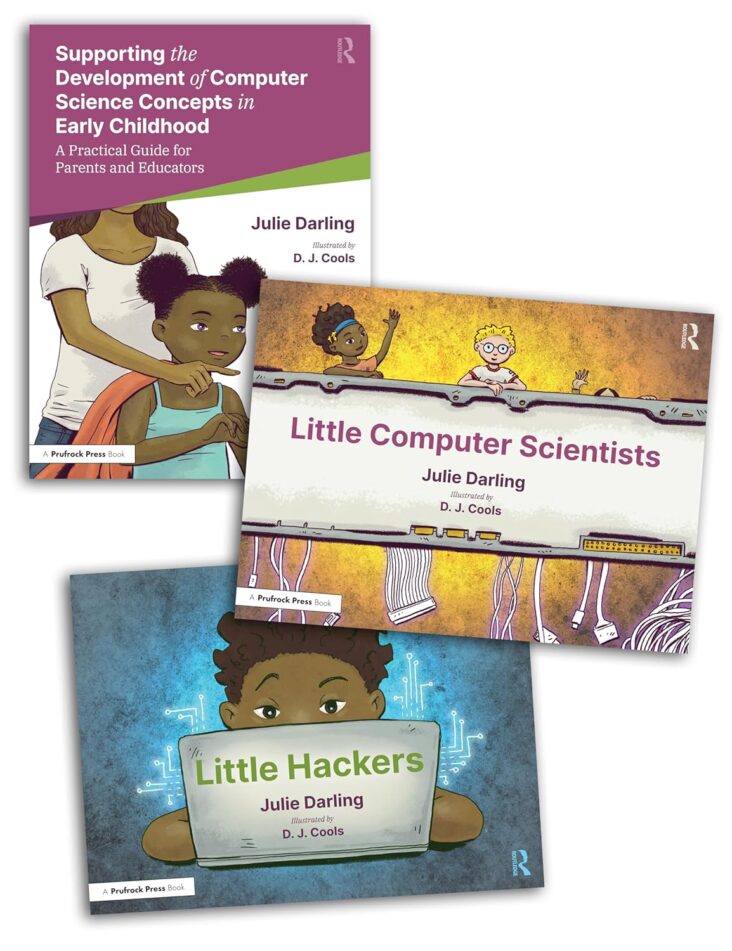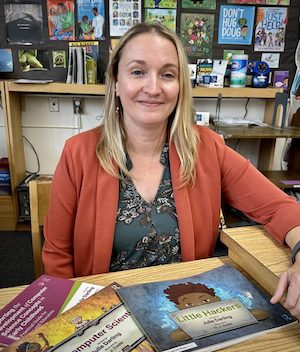By Jo Matthis / AAPS
A2 STEAM librarian Julie Darling, who wanted to be an author from the time she was a student at Abbot Elementary, hopes that her newly published books reinforce the idea that computer science is for everyone.
Darling’s three-book set consisting of two illustrated children’s books and a companion teaching guide offers caregivers and educators the information needed to teach vocabulary and a basic understanding of computer science to children ages 4-8.

The AAPS District News asked Darling about computer science education for our youngest students:
As an A2 STEAM librarian, what inspired you to write books introducing computer science concepts to young children?
A: I’ve wanted to be an author since I was an AAPS student myself. In 4th grade, at Abbot Elementary, I was invited to join a group of students in the library, to write stories. A classmate and I collaborated on a magazine that we sold door to door for 25 cents an issue. I still have the “I Am an Author” certificate that I received from that writing club.
As the A2 STEAM librarian, I read books on a broad swath of topics to students, including books about computer science. In researching age-appropriate books, I noticed a significant gap in stories related to STEM topics that also featured diverse characters, as well as a lack of educational guides for computer science concepts for kids younger than age 8. Around the same time, I discovered a body of research indicating that gender stereotypes start at ages 4-6. These studies linked stereotypical beliefs to disparities in student interest in STEM and computer science. For me, this lent a sense of urgency to create materials to help combat these stereotypes.
Q: How did you approach making complex topics such as binary and ciphers accessible to children as young as four?
A: Explaining complex topics to little kids is where I got the most pushback when I was first pitching this book series to publishers. Oftentimes adults who don’t work with early elementary-aged kids think teaching a topic means you must understand it on a much more complex level than would be age-appropriate. This would be akin to expecting kids to master reading by skipping straight to full words, before learning the shapes of the letters and the relationship between letters and sounds.
In computer science, as in learning to read, it’s important to go slow, keep it fun, and take things one step at a time. In this vein, these books are designed to build vocabulary and give kids an understanding of the mechanics of how things work. Once that’s mastered, kids can jump into block-based coding (ScratchJr for emergent readers, Scratch around the end of 1st grade) and later text-based coding (Python is a good language to start with, as early as age 8, or a bit later depending on prior exposure to
computer science concepts).
Binary was a specific subject that I’ve been told is too sophisticated for little kids. The first time someone said this, I went into the A2 STEAM library the next day and did a spontaneous brain break with a Young Fives class, where I had them repeat the word ‘binary’ back to me, which they could absolutely do. I then explained that binary is ones and zeros and then we practiced holding our hands open for zero and clapping when I said one. Four-year-olds can absolutely understand binary on this level and this is an excellent way to start.
Ciphers are a bit more complex. Developmentally, kids are ready to start learning about ciphers around the end of 2nd grade, when they’re also more confident readers. The best way to introduce ciphers is to write out the alphabet, number it (A=1, B=2, etc.) and then have kids write messages using this ‘secret’ numerical code. By the end of 3rd grade, kids can start creating more complex ciphers by subbing out randomized numbers, letters, or even symbols. Some kids will need a bit more practice encoding and decoding messages before they feel confident with this. This activity is intrinsically motivating because kids love sending secret messages to their friends!
If you want to give it a try, my illustrator designed a template for a Caesar Shift Cipher that you can download for free here.
To assemble, carefully cut out the two circles, line up the smaller one inside the bigger one, poke a hole through the center of both (I use an awl for this, it has to be a small hole to work correctly), then secure with a brad (brass fastener). Make two, shift them in the same direction, and line them up the same way. For example, the outside ring says ‘A’ and lines up with ‘C’ on both. With this specific shift, every time you and your friend want to write a message with the letter ‘A’ you’ll write ‘C’ instead. When you see the letter ‘C’ on your encoded message, you’ll know that it means the letter ‘A’. To put it another way, the outer ring has the correct letters to understand the message, and the inner ring has the letters you’re going to use to make it a cipher. (Write the message in secret code.) If you’re doing this with younger kids, adults and kids can work together to encrypt and decrypt secret messages.
Q: Can you share an example of how you use storytelling or illustrations to explain a computer science concept in one of your children’s books?
A: It’s important to put computer science concepts into a context that’s engaging for kids, so when I’m introducing the idea of a local area network (LAN), it’s mentioned in the context of using it to play Minecraft together.
Q: What challenges did you face in aligning your content with the Computer Science Teachers Association K-2 standards?
A: The first challenge was acquiring permission to use the CSTA standards, which was incredibly nerve-racking since the book deal hinged upon this. Once this was sorted out, I spent a significant amount of time revisiting the standards to make certain that I was capturing what was intended with my activities, games, and songs. I got stuck a few times, so I bounced ideas off some of my A2 STEAM colleagues, who gave me some excellent suggestions for how to capture the standards effectively, and in engaging ways. You’ll notice their names in the acknowledgments section of the guidebook.
Q: How do you balance teaching technical concepts with important lessons on digital citizenship and online safety for young learners?
A: My illustrator and I worked hard to create a diverse cast of characters for the books. My greatest hope is that my students see themselves reflected in the characters. When D. J., my illustrator, was developing the main character I brought in test character sketches and asked my students to give (voluntary) feedback on which sketch they liked best, including the main character Zuri’s t-shirt design. We received hundreds of pieces of feedback from Young Fives – 8th graders which we poured over and utilized to settle on Zuri’s final design. The feedback ranged from hearts and smiley faces to thoughtful written paragraphs.
The most consistent piece of feedback we received is that the students liked Zuri’s rainbow t-shirt, so that’s what she wears in the books. For fun, D. J. also created a design that you can wear in real life.
Q: How can caregivers and educators with no background in computer science effectively use your companion teaching guide?
A: The teaching guide was specifically designed for anyone to use, including folks with no background in computer science. It was written by utilizing the CSTA standards to reframe traditional early elementary activities, games, and songs. For example, instead of Duck! Duck! Goose!, we play Click! Click! Malware! to reinforce that clicking on sites that you’re not familiar with may not be safe. Algorithms are, at their essence, just doing a series of steps in a specific order, such as following a recipe. There are step-by-step directions for making simple trail mix, talking about it as our ‘trail mix recipe algorithm’ and then taking it out on a hike. There are also coloring sheets that reinforce concepts, and printables that walk your learner through specific steps of troubleshooting. I even wrote songs about debugging and having safe passwords.
My overall best advice for effectively using the guidebook is to find something that looks like fun for you and your learner and see what that sparks. However, you could also use it chronologically, should you so choose.
Q: What impact do you hope your books will have on early childhood education and STEAM literacy?
A: My greatest hope is that the books help everyone feel included and excited about computer science. I hope they show kids—and adults, too—how creative and fun computer science can be. I hope they make kids feel confident and interested in technology-rich topics. My ultimate goal with these books was to reinforce the idea that computer science is for everyone and to introduce concepts that hopefully will give students the confidence to continue studying technology throughout their academic careers.
Q: Can you discuss the importance of introducing concepts like “hacking” and “phishing” to young children in an age-appropriate way?
A: Hacking and phishing are things kids are going to encounter on their devices, so it’s important that they have an age-appropriate understanding of what to be careful about. There’s also a shortage of qualified people to fill cybersecurity job needs. If this sparks an interest early, it could potentially lead to a future career.
Q: Looking ahead, how do you envision the role of computer science education evolving in early childhood learning environments?
A: Since computers impact everyone, my hope is that early childhood computer science education becomes the norm instead of the exception.
Q: Was it difficult to get your books published?
A: Short answer? Yes! My first book, Social-Emotional Learning Using Makerspaces and Passion Projects was a five-year saga that spanned three different publishers and two different publishing contracts, not to mention the numerous rejection letters preceding that. After publishing my first book with Routledge, this new series was easier to get published, but I still would not characterize it as easy. It took about two years from start to finish.












